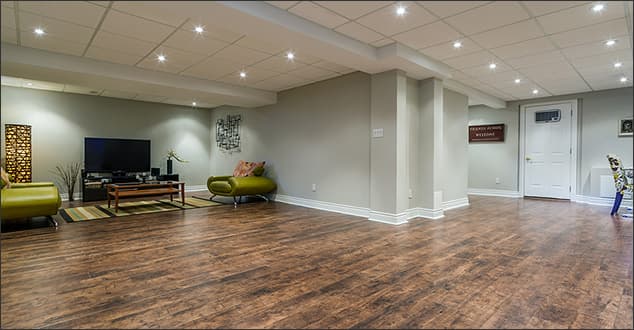Basement Finishing Options: Walls, Ceiling, and Floor Options

Basement finishing presents different challenges than above-ground rooms. Even in the driest basements, you must combat moisture and mold. There are plumbing and ventilation in the ceiling that often must stay accessible.
Moreover, what if your basement floods? Will you risk ruining much of the finishing work, or are there options to withstand a flood?
Basement Flooring Options
Each flooring material has positives and drawbacks. However, some are clear winners when it comes to basement finishing.
- Concrete – Basement floors tend to be cold, which is why owners often shy away from a concrete floor. With new advances in concrete – including stamps, dyes, paints, and stencils that can mimic the look of just about any flooring – more homeowners are turning to concrete. The reason is that concrete is extremely durable. It is possible to add radiant heat to a new concrete floor and non-slip sealants.
- Linoleum – Linoleum falls victim to the same warmth problem as concrete, and they aren’t as durable. They often stain and aren’t easy to repair. However, linoleum comes with more design options for your money than anything else!
- Ceramic Tile – Tile is just about as durable as concrete, and almost as cold. It stands up well to water and moisture but can be very expensive and harder to maintain as the grout stains over time.
- Engineered Wood – Engineered wood is a warmer option that is easier to install, but less impervious to water. This option comes pre-finished and can often be installed in a single day. It expands and contracts with temperature changes, but will warp if it sits in water.
- Cork – Cork is also warm, but it’s very environmentally friendly because it’s harvested from a cork tree’s bark. They don’t have to be cut down. Not all cork is made for basements, so make sure you are getting the right kind. Overall, cork is more durable than hardwood and can be relatively easy to install.
- Carpet – Even though carpet won’t survive a flood, it’s prevalent for basements because of its warmth. The cost of carpeting varies, however, it’s not the most expensive thing out there.
Basement Walls Options
Basement walls are tricky for the same reason as flooring – moisture and flooding events.
However, nothing will make your basement cozier or more useful than putting up interior walls to create more usable square footage and hide the house’s mechanics like HVAC and water heaters. Make sure you or your contractor know to leave adequate air supply for these large appliances.
- Drywall – Drywall remains the most popular finishing material for basements because of how easy it is to install and repair. Drywall is porous and tends to harbor mold; however, it will be destroyed in a flood. Some homeowners use drywall on the upper part of their walls and something more waterproof on the bottom.
- Stucco – This finish is nice because it can be applied right to the concrete foundation of your basement walls, and no extra support structure is needed, as in the case of drywall. However, you can’t paint stucco very easily, and it will crack if your foundation shifts.
- Prefabricated systems – PVC framing and prefinished fiberglass panels and trim make installation quick, and design is done simultaneously. These panels are easy to remove for maintenance needs, but they tend to be pricey. They also won’t fit if your basement is shorter than an average room.
- Paneling – Don’t fear! Wood paneling is better than in the 60s. It’s thicker, and it’s more easily installed. You don’t have to put in studs. And it can be painted.
Basement Ceiling Options
You may have heard that you should never finish your basement ceiling because of how difficult it can be to access needed plumbing and electrical work if you do.
Temporary options can be problematic since basement ceilings tend to be lower than upstairs anyway.
- Drywall – Framing in ductwork and leaving access, and working overhead make this a difficult job for any drywaller. The price will go up accordingly.
- Drop Ceilings – If you have tall ceilings in your basement, a drop ceiling takes care of the access problem. They can be more attractive than what you think, and they can be insulated better than any other ceiling system out there.
- Surface Mount Systems – Those with low ceilings might have the option of using a grid system that only takes about an inch of space, unlike the drop ceilings, which use up 8 inches. These systems use PVC panels that look like tile but leave access to plumbing ductwork.
Basement Finishing Takeaway
There are many great basement finishing options for your budget and design desires to finish the walls, floor, and ceiling of your basement. If you live in Southeast Michigan, please give us a call if you have any questions! We’re always ready to help.




Leave a Reply